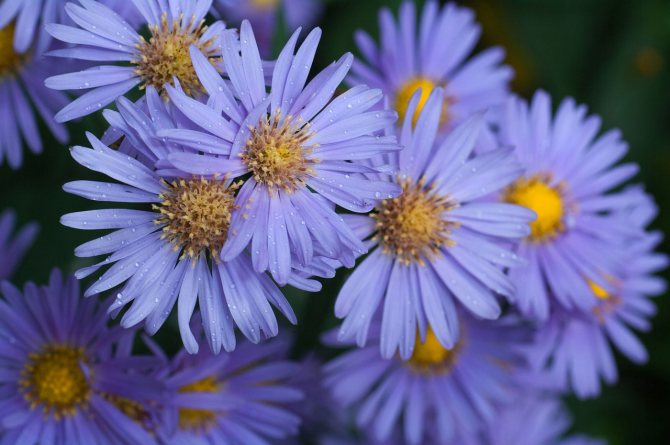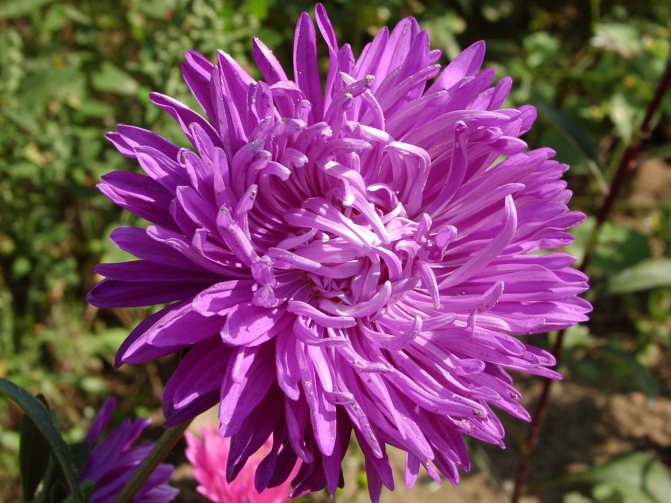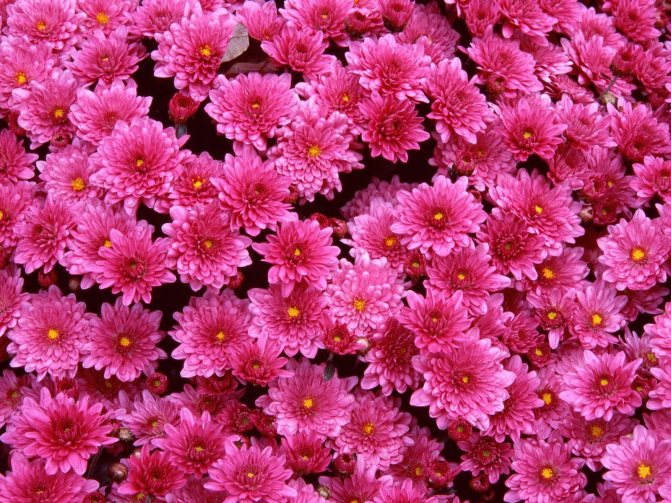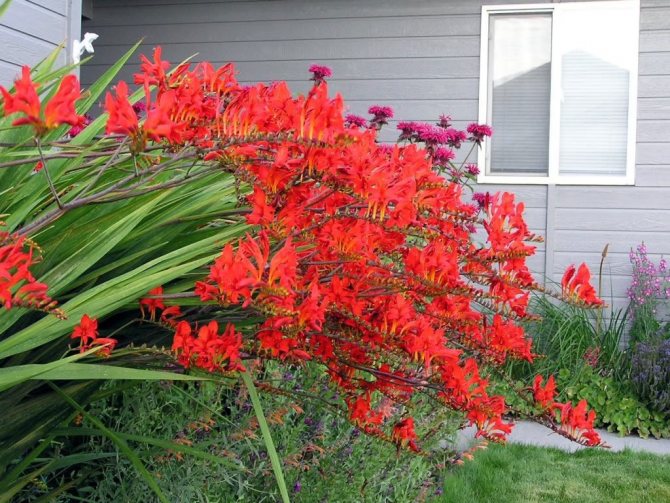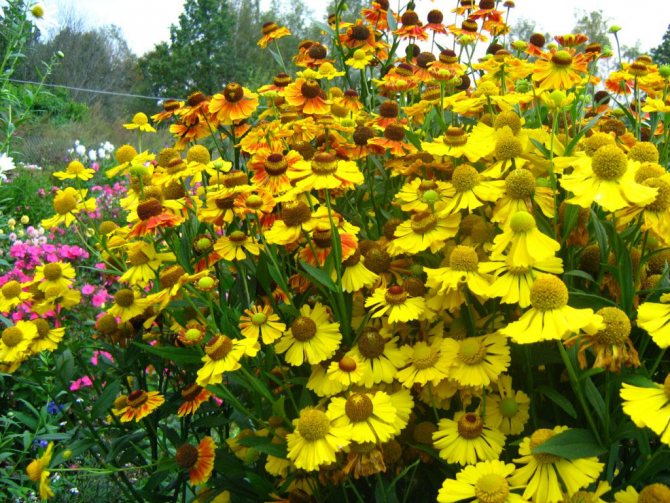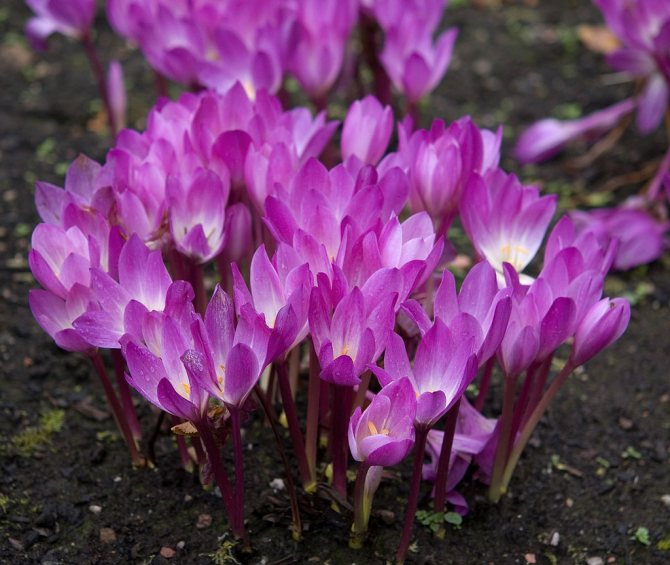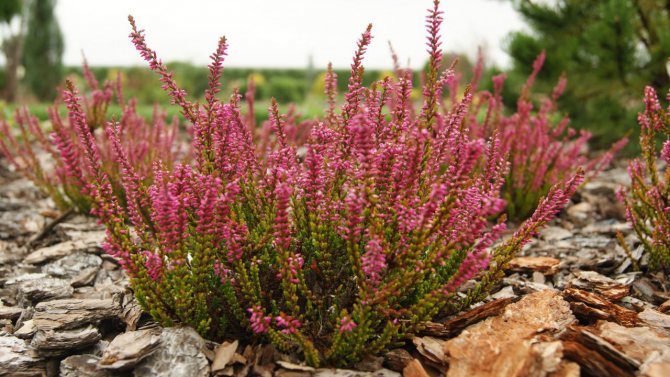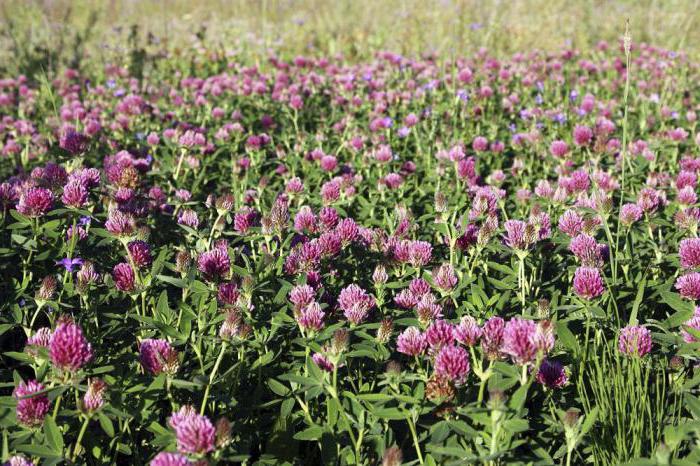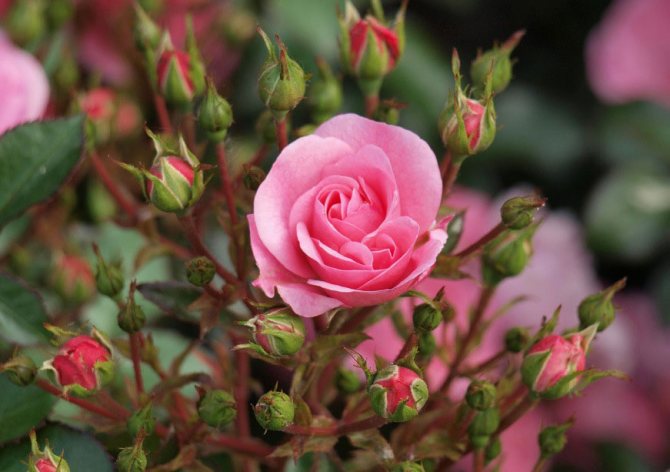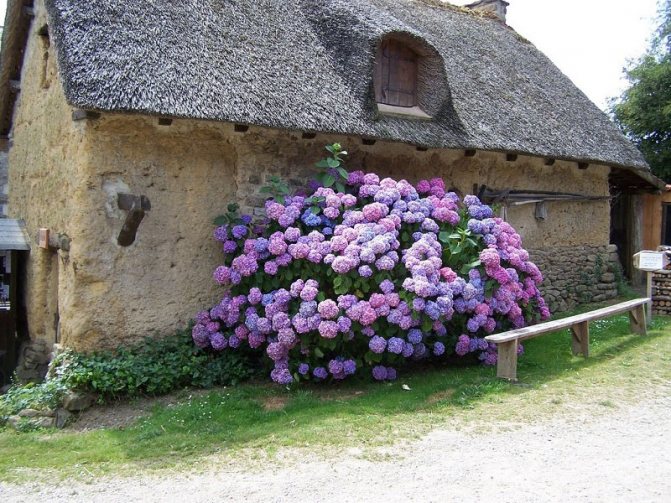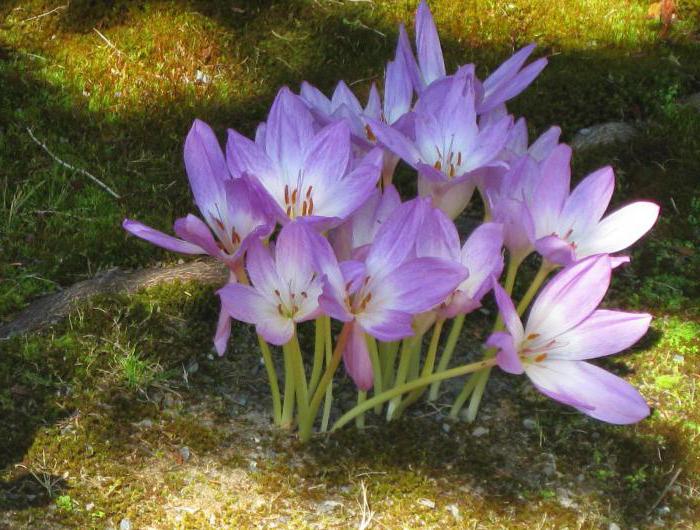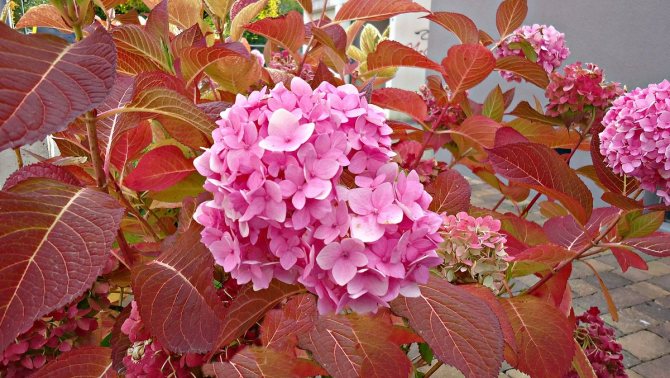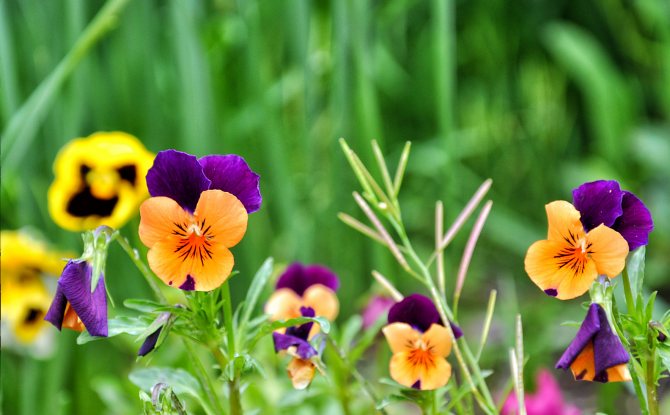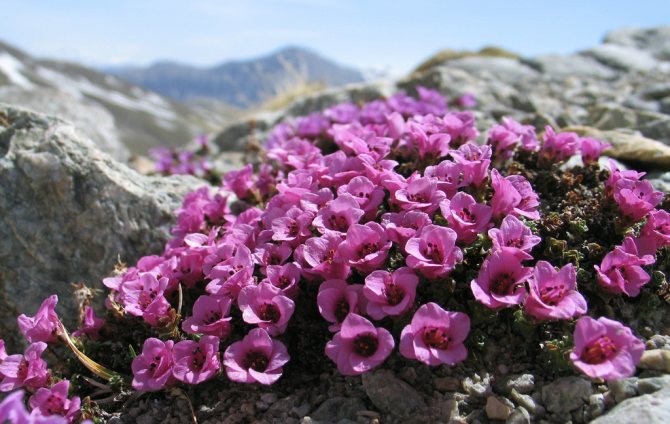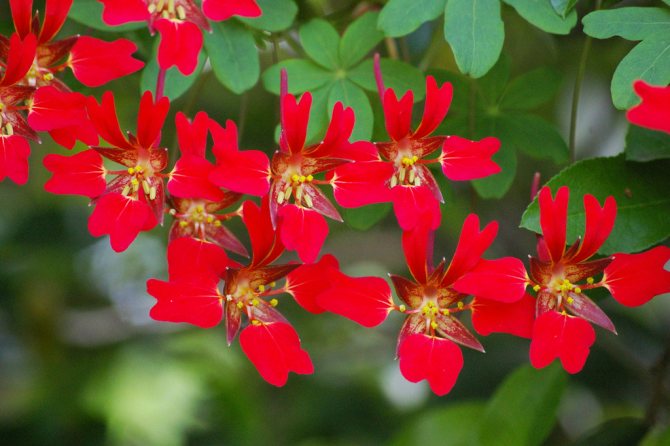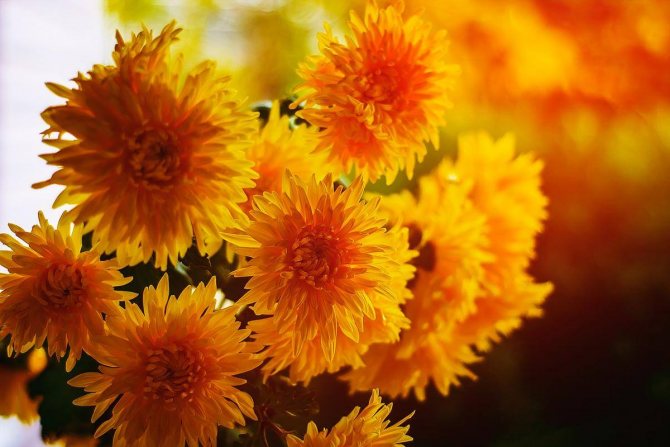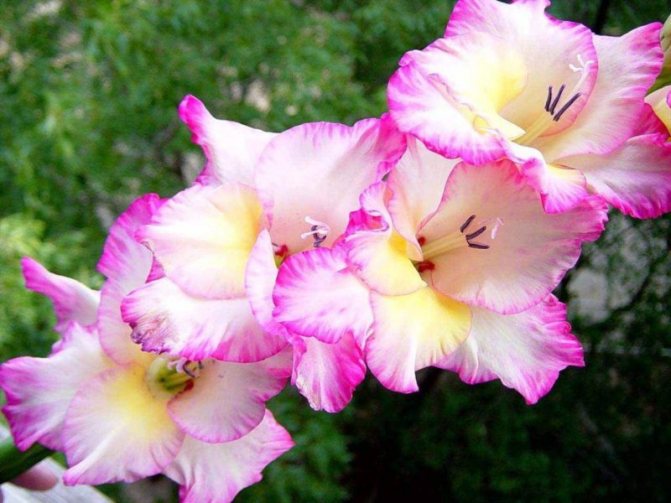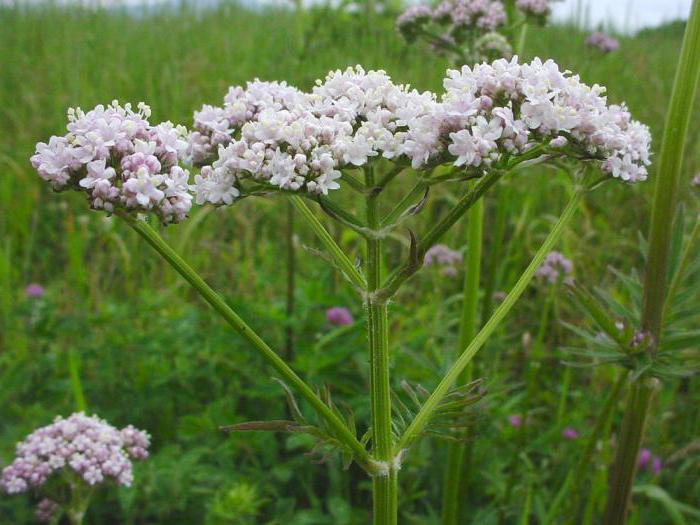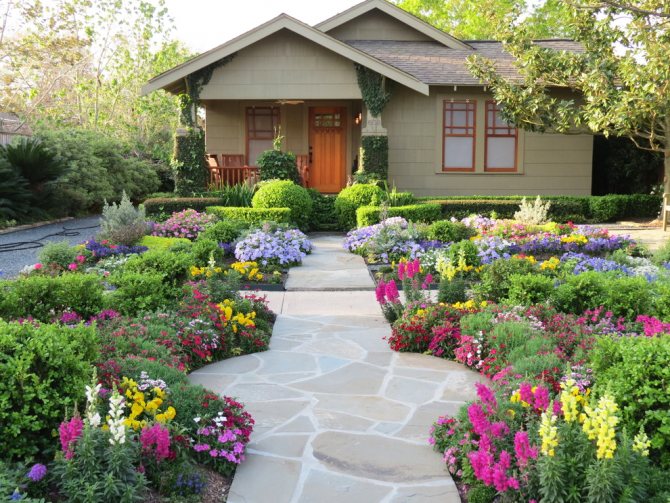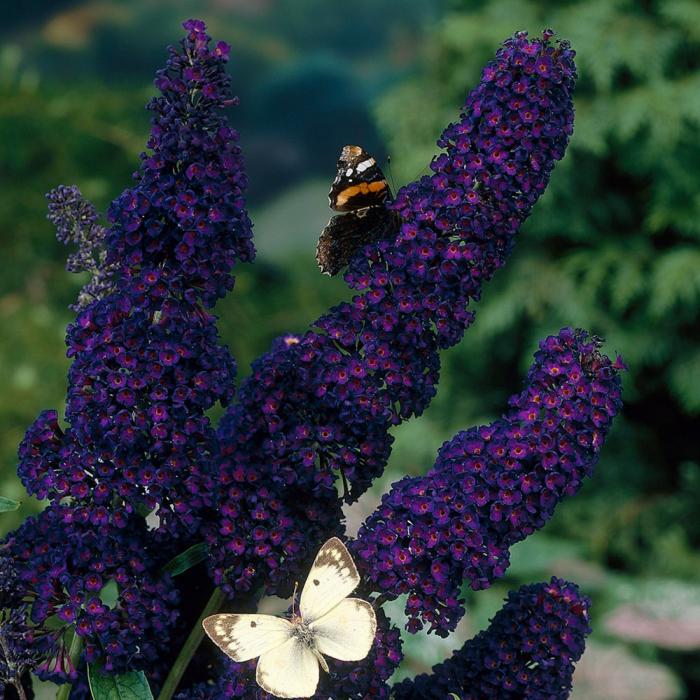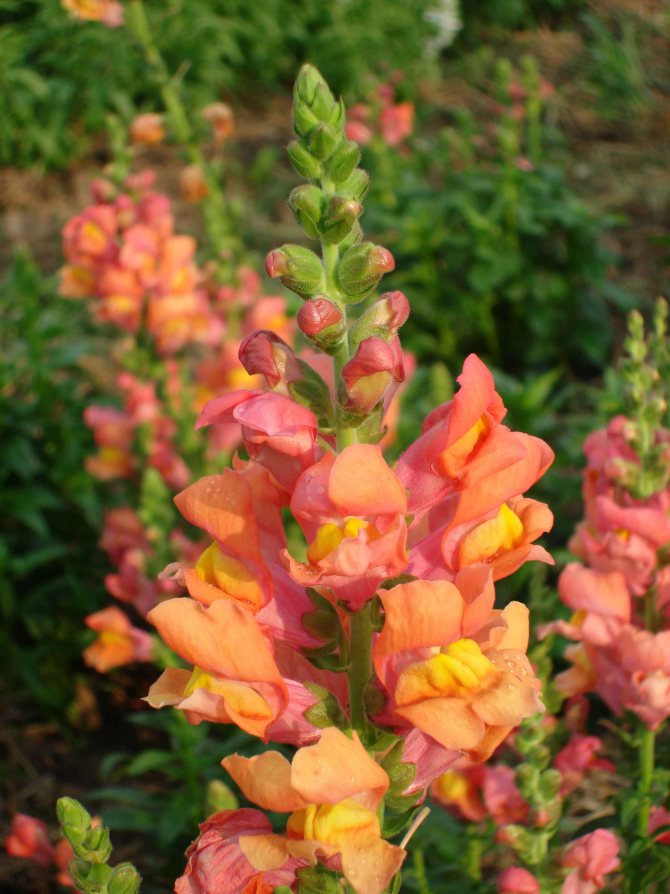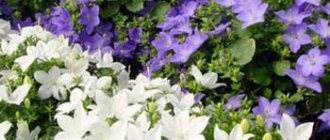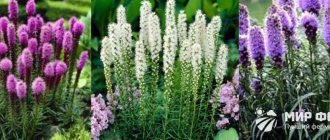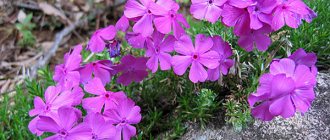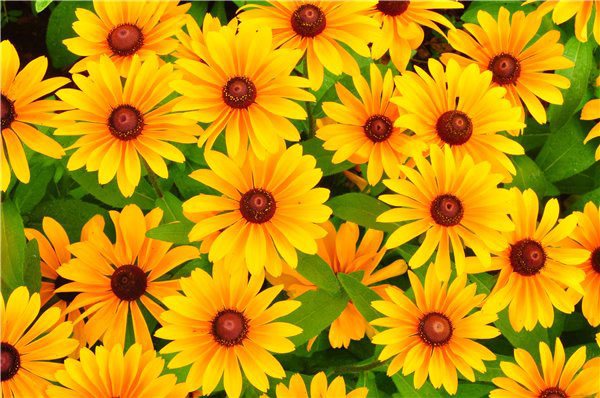
Autumn fills the garden with bright but sad colors. The greenery of the foliage is replaced by red, orange, and yellow. And what about the flower beds? Exuberant flowering ends when summer leaves, and many flower gardens look very deserted ... But knowing what flowers bloom in autumn, you can revive the garden and, as it were, delay the onset of winter.
There are significantly fewer plants blooming in autumn than those of summer and spring blooming, but still enough species are known to be able to create any composition.
CLUB LAW.
Any flowerbed of the correct design has ONLY ONE LAW. And it depends on him whether your flower beds will be a work of art ... or look like a collective farm garden. Let's take a look at the picture below. You see how beautifully the flowers are arranged here.
- The lowest flowers (5-10 cm) are located along the edge of the flower bed - this is the first line of the flower bed.
- They are followed by medium-sized ones (20-30 cm) - this is the second line of the flower bed.
- Then flowers taller than 40 cm - this is the third line of the flower bed.
- And in the background, the highest 60 - 80 cm - the very back of the flower bed.
This is the law of any flower bed.
Here in the photo below you can see how this law is observed in a flower bed with autumn flowers.
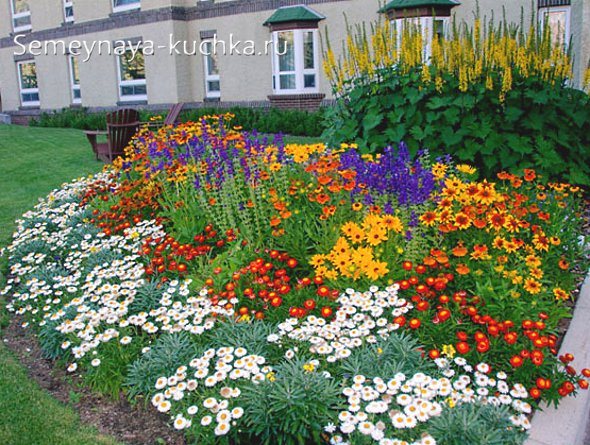

(We will consider all the flowers that you see in this flower bed in our article ... just below)
And here is another flower bed where we see autumn flowers - lush inflorescences of phlox (pink and purple), delphinium (white blue purple - in the background), yellow rudbeckia and marigold, burgundy cellosia, and soil conifers.
Here, too, this law of flower bed lines is observed - built in height.
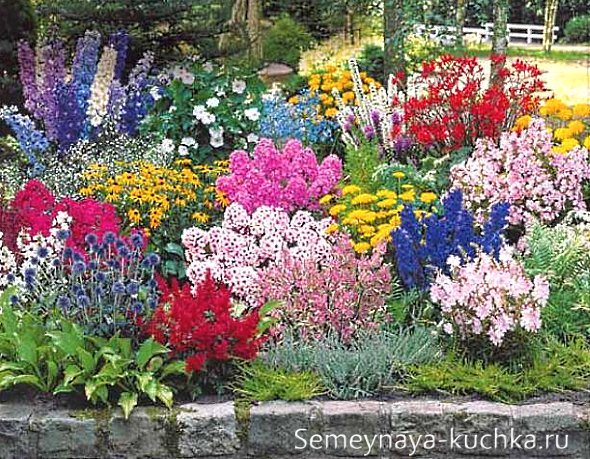

It is important to understand that the same flower has both low-growing varieties (10 cm) and high ones up to 70 cm.
The photo below just demonstrates this principle.
We see an autumn flower bed, on which white delphinium, blue sage, and three varieties of rudbeckia (high yellow, medium pink, and low burgundy yellow).
THIS IS A VISUAL EXAMPLE that one and the same autumn flower (rudbeckia) can give several VARIANTS OF HEIGHT ... AND COLORS ...
And therefore, one variety can be planted ON THE FRONT LINE of the flower bed (like this burgundy-yellow rudbeckia), and another variety ON THE BACK LINE (like a high yellow rudbeckia).
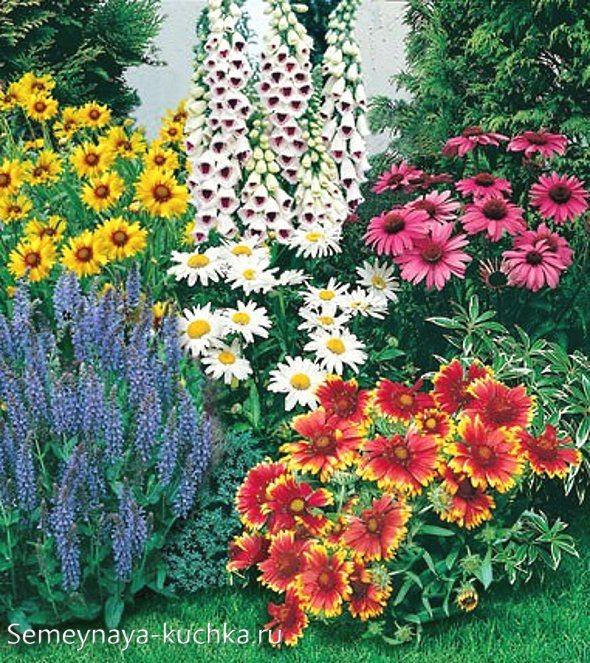

When planting by seeds you can on a bag of seeds read what growth the plant will have, and immediately decide on which line of the flower bed it can be planted.
And if it is a perennial (and you bought it already as seedlings), then it will show itself in the first year of its life in the flowerbed, and if it grows low, you will transplant it closer to the edge of the flowerbed next year ... and if it is high, then it should be located on the flower beds farther from the edge of the line - dig up and transfer to the next height line of the flower bed.
Planting bulbous plants
Bulbous plants of autumn flower beds do not require special care. Many gardeners have heard their names: crocus, beautiful crocus, gladiolus, begonia, dahlia.
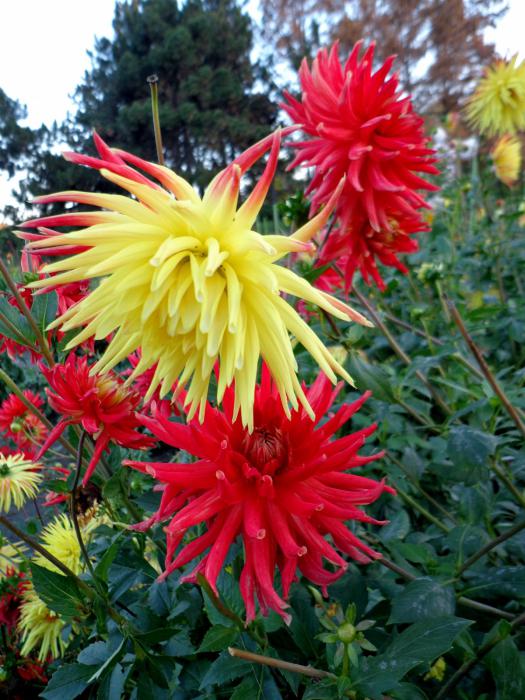

The main difference between bulbous perennials is that the bulbs of some of them should be dug up after the first frost and stored in a cool place. They should be planted in the ground in early spring. Such plants include begonias, gladioli and dahlias.
But colchicum, or colchicum, is planted in July-August, to a depth of about 10 centimeters, in a sunny place, however, partial shade is also suitable. It will bloom next fall. The same should be done with autumn crocuses.
Before planting any bulbs, you should carefully examine and select good, undamaged, large bulbs. Then they must be etched in any of the solutions: potassium permanganate or karbofos.
The soil must be fertilized with minerals. It is best to take superphosphate, potassium phosphate, and ammonium nitrate. Additionally humus. By planting bulbous plants in spring, you can be calm throughout the season - they do not need any maintenance.
for the first line of a flower bed.
So we will start with the lowest autumn flowers - which are planted along the edge of the flower bed - at the curb. Therefore, they are called curbs..
Often, flower beds are chosen for the curb line flowers-pochvokrovy... They are so called because they cover the soil with a thick carpet of flowers - such a carpet very quickly grows to the sides, capturing all bald areas of the earth and the edge of the flower bed looks beautiful and well-groomed.
Let's start our list of border low autumn flowers with just such a soil-blooming fall flower as Ageratum.
Ageratum
Autumn flower-annual.
This is how it looks up close. You met him in the flower beds of the city and village.
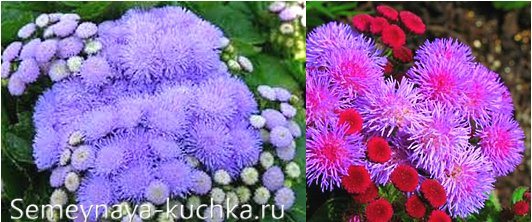

And here is an example of a flower bed where there is a good video of exactly how this autumn flower covers the flower bed and what height this soil reaches in reality. As you can see, not higher than 7 cm. Just for the first line of the flower bed.
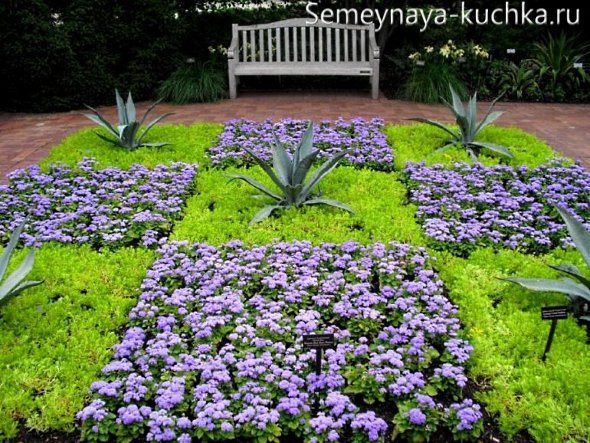

Sowing can be for seedlings or directly into the open ground. In either case, it is better to cover the soil with a film and constantly moisten it with a pulverizer - so that a greenhouse effect is created under the film. This way you get strong shoots quickly.
FLOWERING STIMULATION. In order for the ageratum to give little grass but many flowers, its stems need to be pruned - that is, to thin out the density of the branches, leaving several branches on the stem. Then the strength of the plant will not be spent on leaves and it will give more flowers.
FOOD. This autumn flower does not like fresh manure. Feed with mineral fertilizers and humus. Likes watering, but does not like too much dampness.
WINTERING. In our climate, ageratum does not survive the winter and therefore must be planted again in the spring. Or you can transplant the most beautiful bushes into a pot and bring it into the house, on the veranda or balcony.
VIRULENCE. Ageratum - has poisonous leaves. They cause allergic reactions to the skin and mucous membranes. If you have a child who pulls everything into his mouth, then refrain from this plant.
Dorotheanthus
Autumn flower one-year-old.
DROPPING PLACE. Only a sunny area, in the shade this flower will not give inflorescences, and if it releases flowers, it will not open the buds in a shady flower bed, it will keep them closed. His homeland is Africa - he can be understood.
Therefore, if the border of your flower bed beats the sun mercilessly, then you are lucky you can create a bright scattering of multi-colored African star-flowers. Summer and autumn, they will delight you with their southern optimism.
They also bloom wonderfully at home - in pots, like indoor flowers. 4 seedlings of this autumn flower are planted in a pot for splendor.
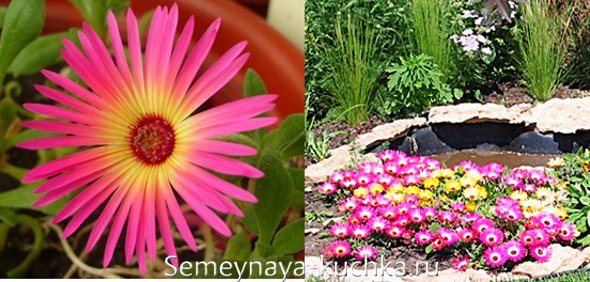

As you can see from the photo, these autumn flowers are low, so their planting line is the border edge zone of the flower bed.
SOWING. At the end of March, under the film, water. But do not let the dampness stagnate (remember that the African flower and excessive dampness are not accustomed to it. They love warmth - therefore it is better to keep the seedlings at 18 degrees. But before planting in the ground, you need to accustom them to lower temperatures. for several hours, and then leave them in such a cool room for good. Landing in open ground - when the night temperature is not lower than 10 degrees. And this is the end of May.
VIRULENCE.In their African homeland, these flowers eaten, as part of salads. Therefore, this view safe for children... It can be grown next to playgrounds or in kindergarten.
Estolzia
(california poppy)
Autumn flower perennial.
Estolzia blooms all summer and autumn. Its bright orange flowers are like the lights of a campfire. The flower is low - so we plant it along the edge of the flower bed.
DROPPING PLACE. Only the sun. This autumn flower adores the sun, drinks it, bathes in it. And all the flowers open only to catch and absorb the sun's rays. In cloudy weather, flowers may not even bother opening the bud, which is in vain to spread the petals apart without a heavenly body.
THE SOIL. Eshstolzia loves dry drainage soils - mostly sandy. It grows well on alpine hills among stones in a gravel road. DOES NOT LIKE acidic heavy (clayey loamy) soils. Does not like damp flower beds.
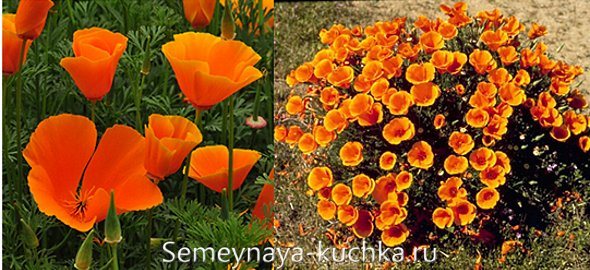

In addition to orange species, there are red and yellow ones.
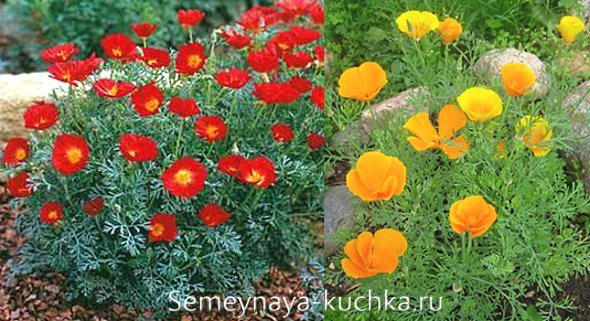

SOWING. This summer-autumn flower is completely unpretentious in sowing. You can simply throw the seeds into the soil, water it periodically to keep it from drying out into a crust (it is difficult for the seeds to break through the dry shell of the crust) and soon you will see the floral carpet of this Californian miracle. It is best to mulch the seeds thrown into the ground (with crushed foliage, sawdust, straw, bark - this will also prevent moisture from evaporating quickly and will not allow a crust to form on the soil surface. And the seeds will sprout quickly and quickly. If the seeds are kept on the lower shelf of the refrigerator (tempered) - then sowing can be done immediately after the snow melts.
IRRIGATION AND FOOD. Eshstolzia loves the sun and therefore easily refers to the aridity of the soil. It holds its thin neck firmly even on the hottest, driest days, patiently waiting for rain or watering. For this patient flowering, all gardeners love and respect him. It is necessary to water the flowers in the eveningwhen the flower cups have already closed.
FLOWERING STIMULATION. To speed up the formation of buds and the splendor of flowering, this autumn flower must be fed. Mineral fertilizer + any other universal flower + Vermisol. You can immediately make a cocktail - a teaspoon of each substance in a bucket of water. And water as usual.
VIRULENCE. Plant not poisonous... That is, it is safe for places where children wander unattended. You can allow children to pick the cups of flowers and play with them (bury secrets in the ground under a glass, or turn them upside down and get a fluffy princess dress. Do not feel sorry for these flowers - because everyone flower-cup lives only 3 days. The flower dies off and a new bright light of the Estolcia immediately opens up nearby.
WINTERING. Eshstolzia reproduces by self-seeding. In the fall, she will throw seeds around. They will overwinter in the soil and will give new cheerful shoots in the spring.
Dimorfoteka
Annual flower.
DROPPING PLACE. Demorphoteka is also a guest from Africa. Therefore, he also loves to swim in the sun. We plant it only on pieces of a flower bed open to the sun - it is there that it will give a bright carpet of flowers.
DOES NOT LIKE dampness. Do not plant next to a drain. Loves ventilated places, grows well in a windy section of a flower bed.
THE SOIL. Not heavy, well-drained (that is, it does not retain water) - sandy. If you have heavy soil in a flower bed (clay, loam), then you can specially dig a hole under this flower - pour sand into it, mix it with organic matter (compost) and plant dimorphoteka in this oasis. She will love it.
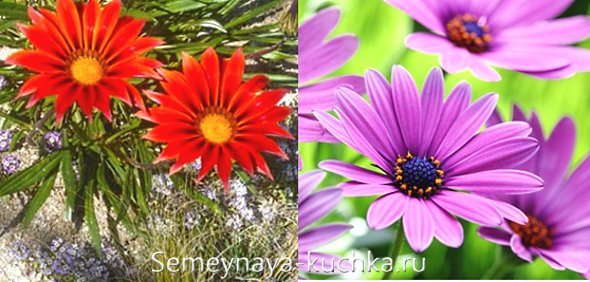

They feel great in pots, baskets, on small areas of soil - islands of earth between stones are great.
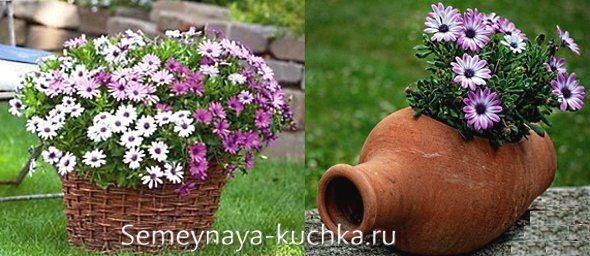

SOWING. Under the film in boxes. Keep at a temperature of 15 degrees or higher. The flowering period is 70 days. Therefore, for the plant to bloom in autumn in September. Sowing can be done in June and transplanted later in July. And we will get a bright autumn flower.They can be planted in the place where the bulbous flowers have already bloomed and you dug them up for storage until next year.
FEEDING. Any universal fertilizer for flowers. During the budding period and at the end of August to enhance flowering in September.
VIRULENCE. This autumn plant is not poisonous. Can be planted in the country with small children.
BEGONIA ever-flowering
(blooms all summer and autumn).
We are all familiar with begonias from early childhood. We often saw her in pots in the form of a houseplant. And it is most often grown in parks and city lawns. This is the kind of begonias we see most often - with rounded glossy leaves and small crunchy flowers.
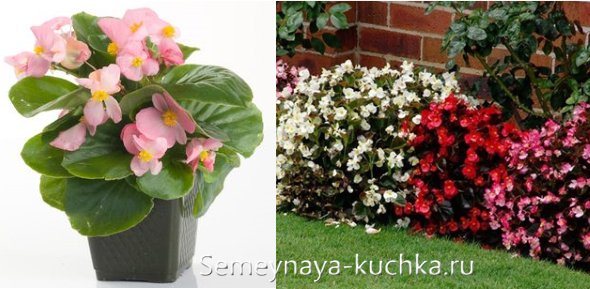

But begonias have hundreds of varieties. And every year more and more are brought out. There are a huge number of collectors in the world who devote their whole lives to collecting all types of begonias in their garden. Below we see what lush varieties this autumn flower can have.
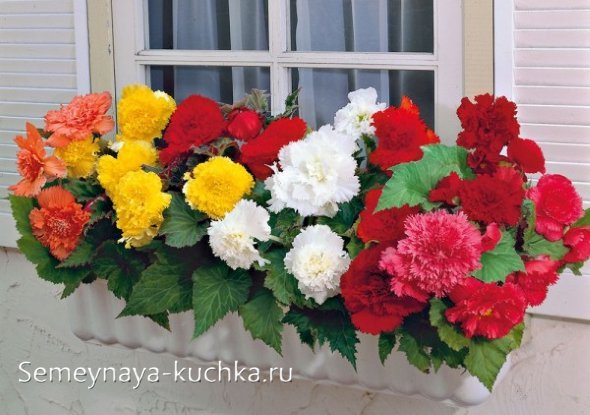

In autumn, this flower produces the same beautiful flowers as in summer. Therefore, we also place it in our article dedicated to autumn flowers.
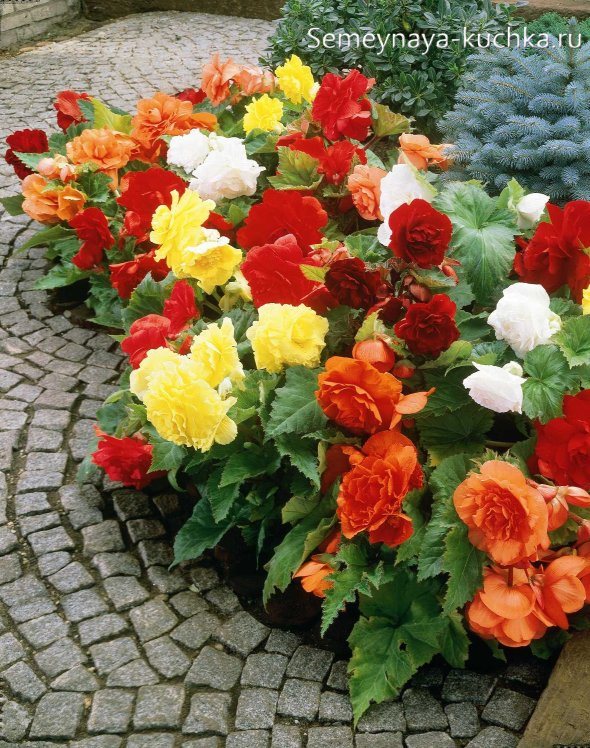

DROPPING PLACE. Begonia is native to tropical rainforests. It grows in the shade of tropical trees, under their dense canopy it is warm and humid. The same shaded and moist area should be highlighted in your fall flower bed.
DOES NOT LIKE - direct sunlight (leaves get burned). It is best if diffused sunlight falls on the begonia through the crown of a bush or tree. DOES NOT LIKE - when water is poured on top of the leaves. Better to pour on the ground under the bushes. And mulch the soil (sawdust, straw, mulch, bark) - so that the earth retains moisture for a long time (but this flower does not like abundant watering with stagnant water).
THE SOIL. Begonia loves slightly acidic soil. In alkaline soil, it will grow, but will not give flowers.
FLOWERING STIMULATION. To prevent begonia from getting sick and blooming profusely, it should be watered once a month with a slightly pink solution of potassium permanganate. The same solution will protect begonia from powdery mildew. In the same way, watering with slightly acidified water has a beneficial effect on begonia - a spoonful of vinegar in a bucket of water.
REPRODUCTION - tubers and cuttings. If you walk past a beautiful begonia, tear off a stalk with leaves (the top of a branch) from it. Dip it in water and it will give roots (so that the rooting process takes place faster, you can moisten the cut of the cutting in a root enhancer (purchased or homemade). You can make such an amplifier yourself by mixing honey and aloe juice. Add a teaspoon of this balm to a glass with a cutting and the roots will not be long in coming.
Transplanting autumn perennials
Perennial plants of autumn flower beds must be transplanted periodically, carrying out the procedure for dividing the bushes. If they grow strongly, they will lack nutrients in the soil, as well as moisture and light.
Transplanting perennial flowers is best done during a period of calm growth. First, the place is prepared: the earth is dug up and mixed with fertilizers. Then the holes are prepared, which are watered with water. Before digging up the plant, it must also be watered. The shovel is pushed into the ground carefully and at some distance from the stems so that the roots are not damaged. The plant is taken out along with a lump of earth and immediately placed in the hole, if separation is not required. Sprinkled with earth, which is compacted. Then the plant is watered with water.
When transplanting tall perennials into the hole, you immediately need to drive a peg in order to tie the growing stems of the plant to it.
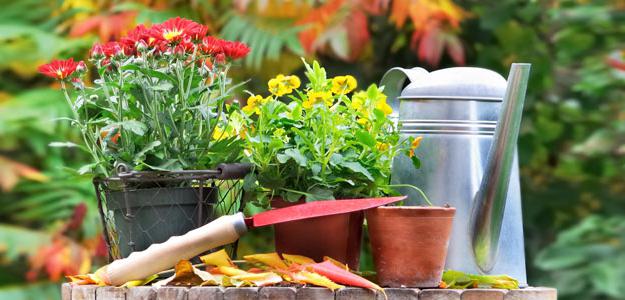

blooming in autumn.
Ground plants are often used in AMPEL (suspended) plantings. That is, they are planted in pots, hanging pots. Having taken possession of the limited space of the pot, the flowering curb pochvokrovnyh create a FLUFFY BALL, behind which even the container is not visible in which they grow
Let's take a look at some fall flowers you can use in ampel plantings and in suspended flower beds and pots.
Of the autumn flowers, these are 4 species that bloom all summer and the warm part of autumn - rock alyssum, lobelia, lavatera, petunia.
Rock alyssum
These beautiful, abundant flowers bloom all summer and warm September. When planted in a pot, they give a lush flowering cap. They are also used as border flowers for the first line of a flower bed. Planted on alpine hills between stones.
And it is also planted in place of faded bulbous flowers (daffodils and tulips) - they quickly grow and occupy all the bald spots of the flower bed.
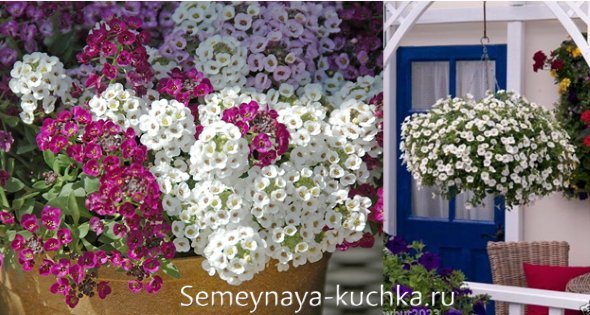

THE SOIL. These summer fall flowers love well-drained soils - that is, those in which water does not stagnate - that is, sand. It grows well between stones, in the cracks of the sidewalk. In terms of acidity, neutral soil is either slightly acidic or slightly alkaline (that is, closer to the middle).
SOWING. You can sow alissum in March, but then the seedlings will sprout late. Better in November - the seeds will overwinter and get stronger and come out with an even carpet in early spring and bloom earlier ... and will bloom all summer and all autumn. If the seeds are poured out thickly, then the seedlings will need to be thinned out so that they do not strangle each other. It is best to keep a distance of 40 cm between the bushes (then they will grow comfortably).
Seedling in a box requires slightly alkaline soil with a little lime (pH 5.5-6.2). After the first leaf, feed with fertilizer for flowers. After 2-3 leaves, you can plant it in the ground.
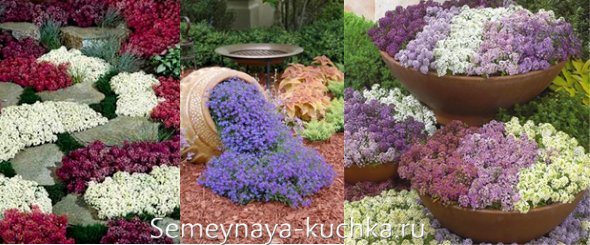

WATERING. These fall flowers do not like excess moisture and frequent watering. To find out if it's time to water the alissum, you need to dig the soil 3 cm deep - if it's dry, you can water it - not much.
FOOD. Alyssum loves nitrogen fertilizers - 1 table meadow Agricola-7 + 1 tbsp. a spoonful of urea - in a bucket of water.
FLOWERING STIMULATION. Before flowering, we feed with any complex fertilizer for flowers.
Lobelia
(herbaceous varieties)
Lobelia are summer-autumn flowers, which have several hundred varieties - both shrubby and herbaceous. We choose low-growing herbaceous varieties as our border flowers.
LANDING PLACE. This flower loves not very nutritious soils (loose and light soil with sand or loamy composition is perfect). Lobelia LOVES SUNNY flowerbed areas.
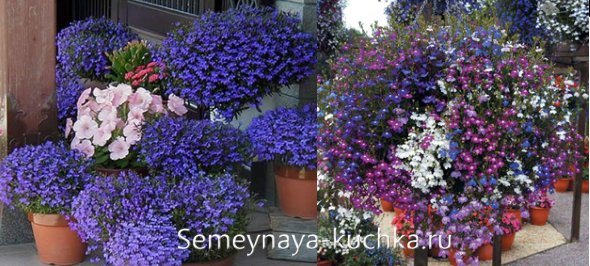

IRRIGATION - The juiciness of lobelia requires constant replenishment of water.
DIET - Lobelia does not like heavy food such as novoz, thick compost. Light mineral fertilizers are enough for her
STIMULATION OF FLOWERING AND BRUSHING. If you just sow lobelia and wait for a beautiful bush, you may be disappointed. It is best to trim the lobelia seedlings yourself (cut off the tops of the shoots with scissors) - so that the trimmed branches release side shoots abundantly and a dense bush forms, without bald spots. And then the bush will take on a beautiful spherical shape by itself
SOWING. Lobelia is sown in February. First, we put a drainage layer (pebbles, expanded clay, or pieces of bark) into the boxes, that is, a layer into which excess moisture will drain. Then we pour the purchased soil upstairs, having previously mixed it with sand and coconut fiber. This will make the soil more crumbly and less heavy. Lobelias do not like heavy soils. Pour lobelia seeds directly on top of the ground and bury them (so they will not germinate), but simply sprinkle them with fine river sand. Cover with foil and set in the light. Watering from a spray bottle.
Petunia
Summer flowers blooming in autumn
LANDING PLACE - The sun, the more the better.
SOIL - neutral or slightly acidic.
GROWING - start sowing in March. The composition of the soil for planting seeds consists of peat, humus, turf and some sand. Pour expanded clay at the bottom of the box, prepared soil on top. We spray the ground so that it becomes wet, and pour petunia seeds over it in rows. DO NOT sprinkle them with earth, just press down lightly with your finger - so that they stick to the ground. And that's all.Petunia loves light, from her youngest days - even petunia seeds love to lie openly in the light. The box is covered with glass or transparent film. And they put it on the sunniest windowsill. A temperature of 24 degrees is the most favorable for the germination of these autumn flowers.
After germination of seeds, seedlings begin to harden. Gradually, day after day, they remove the glass - first for 5 minutes, the next day for 10 minutes, the day after tomorrow for 20 minutes. And so the time is gradually increased, and then the glass is removed for good.
You can dive sprouts from a common box into separate cups when they have 2 real curly leaves.
For the first month, the seedlings will stand still - neither increase nor grow. This is normal. This is due to the fact that during this period all forces are spent on strengthening and growing the root system. As soon as the plant has strong roots, it will begin to pour forcefully into its above-ground stem part.
LANDING IN THE GROUND in mid-June, when the plant has already become an adult and even released flowers.
The story of an autumn flower garden plant
Our choice fell on the dahlia. In terms of the splendor of flowering and its duration, dahlias, perhaps, have no equal. A large number of varieties have been bred, differing in color and shape of flowers and leaves, height of bushes.
Dahlias love sunny places, protected from the wind, and the soil is loose, fertile.
They should be planted when the ground is already warming up well (late May-early June). Pits for planting tubers should be prepared in advance, they are dug to the depth of a shovel bayonet. Rotted manure, superphosphate, complex fertilizer, ash and lime (the latter in a handful) are poured at the bottom of the pits. Everything is mixed with sand. Tubers are planted to a depth of 10 cm (previously large ones are divided into several parts), covered with earth and watered well.
Taking into account the fact that the stems of dahlias grow quite tall, you should immediately set pegs near the hole with the planted tubers, so that you can later tie the stems to them.
(for the second line of the flower bed)
Gatsania
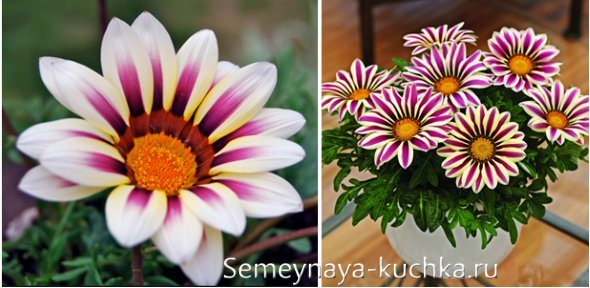

Anemones
autumn flowers perennials.
LANDING PLACE - Sun or weak partial shade.
GROWING. You can plant seedlings - but then you will see flowers only in the third year .. Therefore, it is easier and faster to root sprouts with roots from a large bush from a neighbor. These fall flowers take root and grow very quickly. Therefore, immediately plant them away from other perennials.
WINTERING. For the winter, sprinkle these autumn cut flowers with peat or a layer of compost.
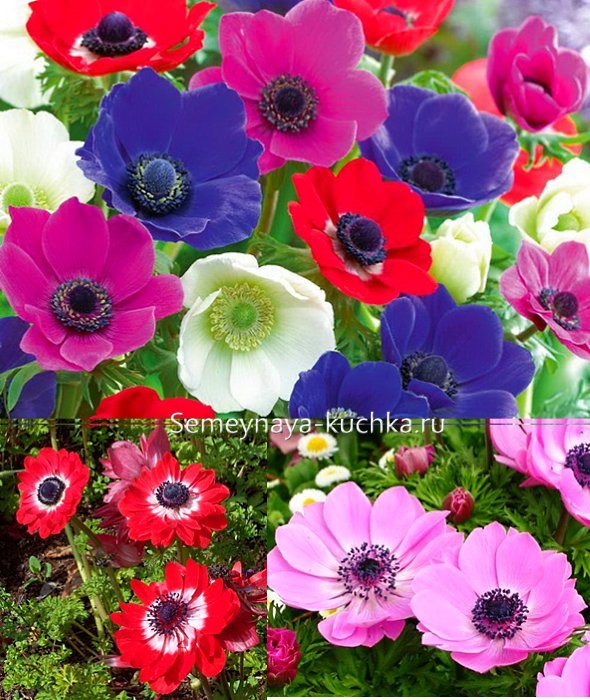

Marigold
hardy autumn flowers.
LANDING AREA: Marigolds love light, non-clay soils. Feel good in open sunny areas. In the shade, these flowers will not be strong and blooming lush.
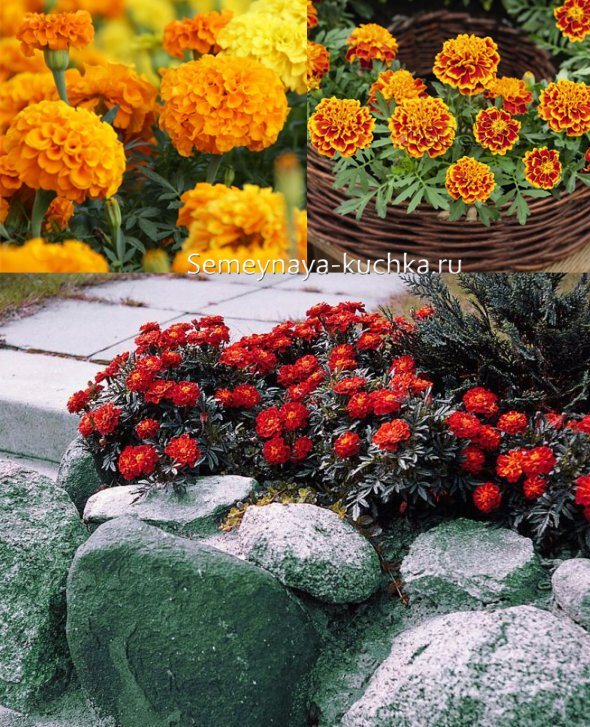

SOWING. For seedlings, marigolds are sown in March or April. Marigold seeds - we wrap them in a wet scarf, wrap them in foil and put them in heat (on a battery) or on our body (in a bra, for example - the seeds on the body germinate very quickly). When the seeds hatch, they can be planted in boxes with earth. Or to the prepared section of the flower bed, if it is already summer in the yard and it is warm enough for the seeds (sprinkle it with earth on half a centimeter, water it from a spray bottle, cover it with a film). We thin out the first shoots.
Snapdragon
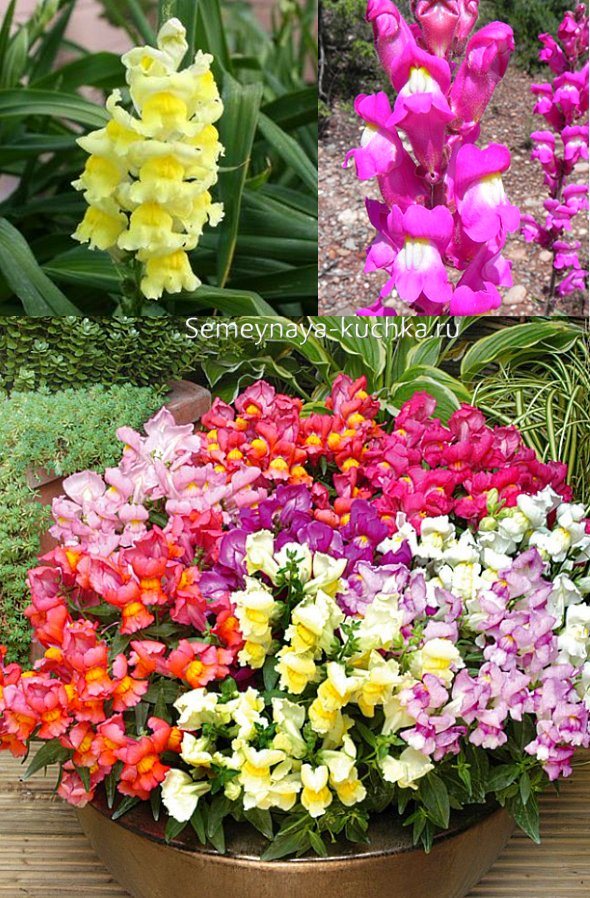

Godezia
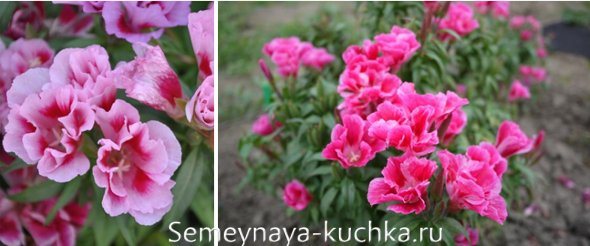

Nemesia
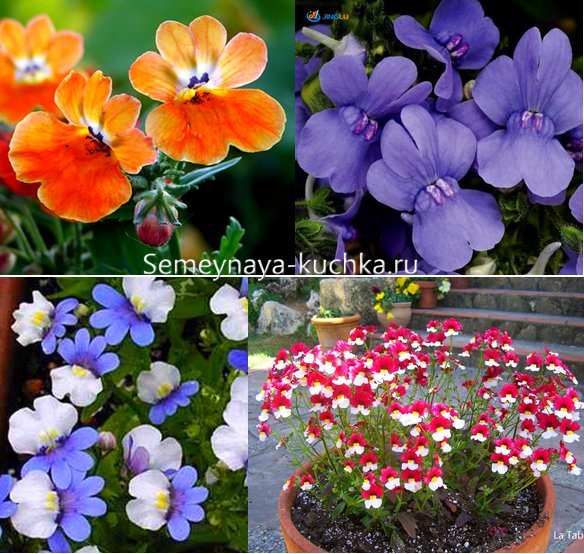

Celosia
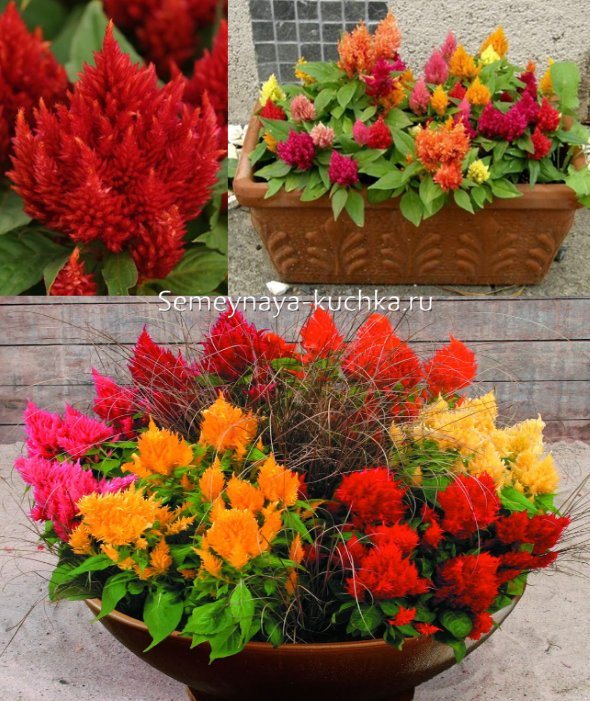

Verbena
(Verbena)
Verbena is one of the most beautiful autumn colors that bloom until frost.
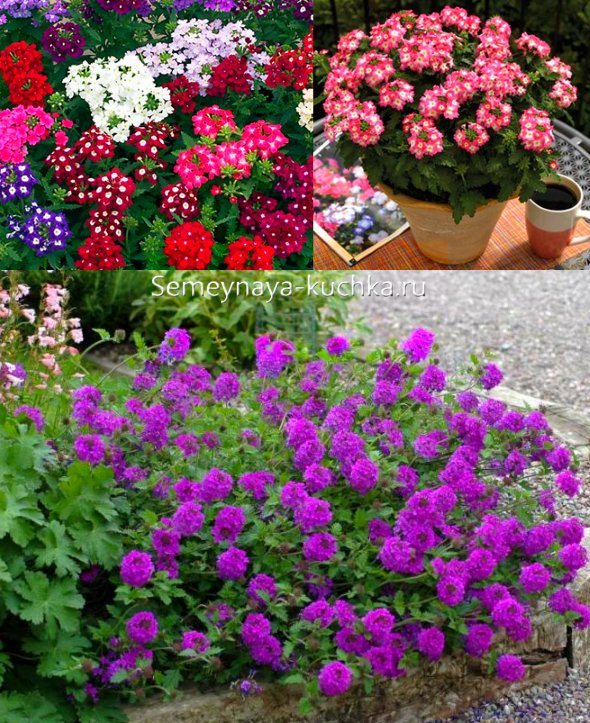

LANDING PLACE. This autumn flower feels good on any soil, provided that you carry out mineral dressing twice a year. Verbena blooms better and more abundantly in sunny flower beds, but it will give flowers in partial shade.
GROWING. Seeds are sown in March. Disembarkation is carried out in June. Before planting, the seedlings are hardened, for 10, 20, 30 minutes, the seedlings are taken out into the street, gradually accustoming the verbena to the cool climate.
Autumn color classification
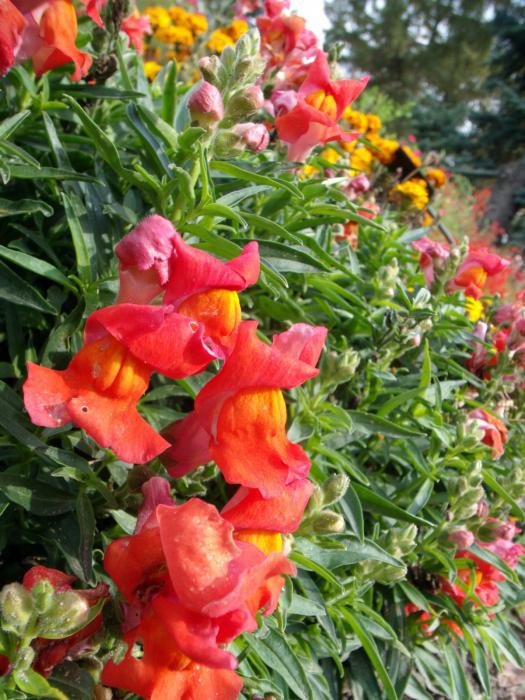

Autumn flowers delight not only with a variety of colors, but also with rather long flowering periods. Most of them bloom in August and can bloom in September, October, and some also in November, until frost comes.
Plants of autumn flower beds can be of the most varied colors. Red, orange, yellow, white, pink, lilac, blue ... And even motley.
In the shape of the flowers and the height of the stem, plants blooming in autumn can also differ significantly.
All these distinctive features can be skillfully used when laying out flower beds. For example, competent gardeners skillfully combine plants according to the color scheme, as well as according to the flowering period. Plant height also plays an important role in the correct organization of flower beds. Taller plants should not obscure the lower ones, and thicker ones should skillfully set off single specimens.
If we talk about the scientific classification, then autumn flowers are divided into annual and perennial. The latter, in turn, are bulbous.
(third line of the flower bed)
Phlox
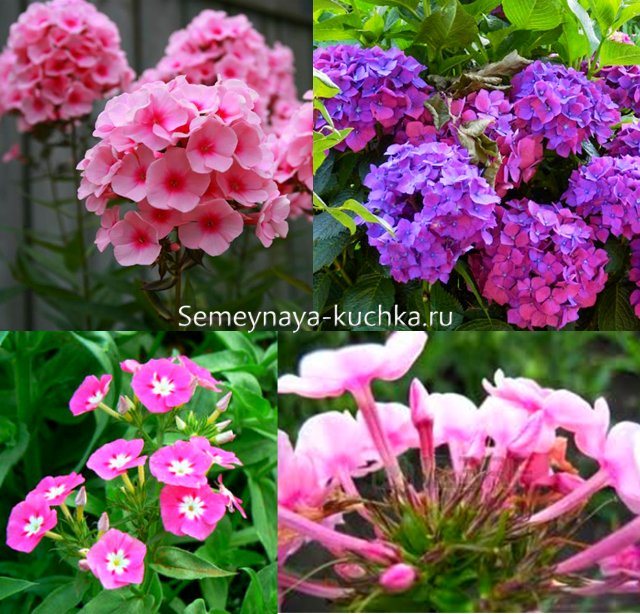

Zinnias
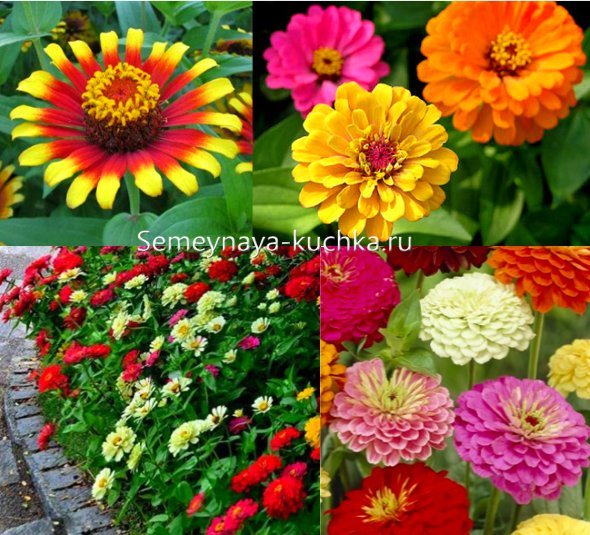

Chrysanthemums
Chrysanthemum
PLANTING PLACE - These fall flowers love sunny areas. They are very fond of the sun, very sensitive to light. Therefore, it is not recommended to plant them near garden lights or windows, from which light pours for a long time in the evenings. In chrysanthemums, then the light rhythm is lost and they bloom less.
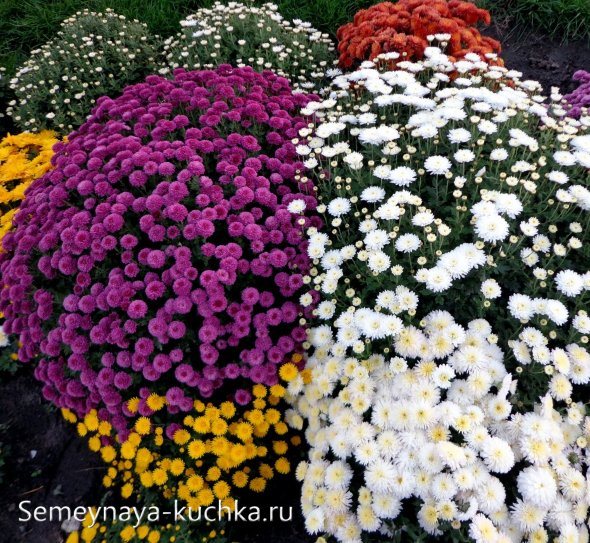

NUTRITION - these autumn flowers, like real sensitive ladies, eat little. One spring dressing and one during flowering. If you feed them more often, for the company with a neighboring bush, then they begin to behave inadequately - the stem will stretch up, thin, long and fragile and weak before any infection.
PROTECTION - Spray these flowers with antifungicides to prevent slugs and aphids from eating them. And then the autumn bloom will be long.
REPRODUCTION - perfectly reproduce by cuttings. Broke off the bouquet. Stuck in the ground (in a pot. And it will take root in 2 months
Perennial asters
Asters are very different ... So much so that they seem alien colors to each other. There are asters 80 cm high. There are asters 5 cm low - which are often confused with daisies (because of the chamomile type of flower). There are asters with large flowers - lush and round like peonies (and then they are even confused with peonies). There are asters with small flowers (5 cm in size) - and then they are very similar to chrysanthemums. By purchasing asters of different height and size, you can create a very diverse flower bed - and everyone will be surprised to learn from you that these are all asters and nothing more.
Here are some of the varieties of autumn colors - asters.
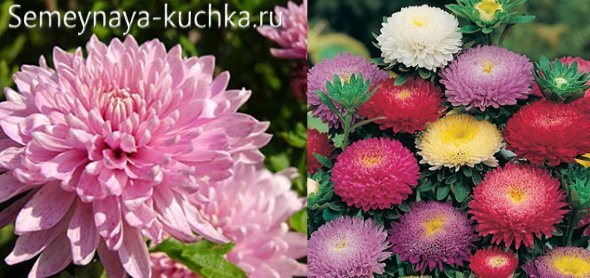

ASTERS SMALL IN HEIGHT - the names of such asters often contain the words baby or dwarf (Royal dwarf, Baby curb (bright pink), Autumn Olympics (blue autumn flowers), snow-white aster Vologda lace.
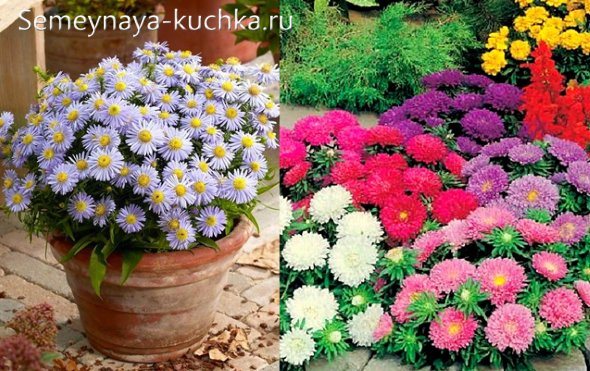

ASTERS HIGH - Peony aster (with double round flowers - types of Rosanna, Apollonia, Gala). Needle aster with sharp petals - such types as Assol, Night star, Isadora. Pomponnaya aster (beautiful varieties Winter cherry, Harlequin)
DAHLIA
Dahlia
Dahlias are also flowers that are very different in their appearance. There are anemic dahlias (very similar to anemones). There are peony dahlias (very similar to peonies).
Spherical (spherical), pompom, nymphaean.
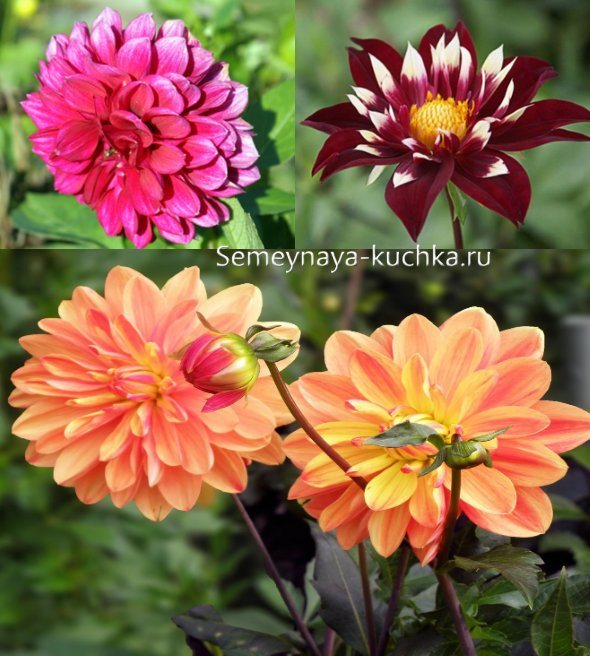

FOR THE FLOWERS TO BE LARGE - you need to remove excess inflorescences on the stem. 5 pieces came out, you remove two - leave only three, and then they will be large and lush. Better than five small flowers. Once the flower has faded, remove it so that it does not siphon power from the remaining flowers.
SOIL - neutral or slightly acidic. If the soil is alkaline, it can be acidified with peat or compost, or sprinkled with water and lemon juice. The soil is prepared in the spring before planting these autumn flowers - they spread compost, acidify the soil with wood ash.
LANDING AREA - These fall flowers love a sunny outdoor area.Draft protection. Not from the wind, but from strong continuous through streams.
CARE - Every three years, the dahlia should be repotted, the earth should be allowed to rest (otherwise the dahlias will get tired and begin to bloom poorly). The soil around the dahlias should be constantly loosened. And if you are too lazy to do this, then you just need to mulch it (cover it with bark, straw, dry leaves. Dahlias have a heavy flower and a fragile stem. Therefore, flowers need to be tied to sticks.
WINTER - dry the tubers dug up in autumn, sprinkle with sand, wrap in paper and in a bag. We store in a loggia with a temperature of at least 5 degrees (or in the refrigerator). AND THERE IS ANOTHER WAY - one that does not require cold. Melt a paraffin candle in a saucepan - dip the tuber in it twice. Wrap in a newspaper and put in a bag - in the spring, wipe off the paraffin and plant.
They are planted most often
The most popular are perennial plants in autumn flower beds: chrysanthemum, aster and helenium. Let's talk about the first two in more detail.
The chrysanthemum is often called the "queen of autumn". Its flowers are distinguished by a wide variety of shades and shapes. Ordinary double and semi-double inflorescences are white, yellow, pink, red, cream, lilac.
Garden chrysanthemums, depending on the variety, bloom from late August to late October and even later, until the very frost.
Hello dear friends!
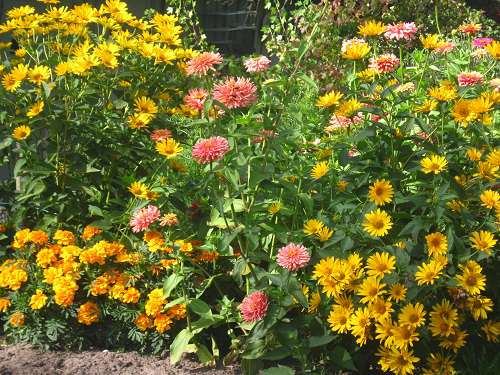

September ... At the beginning of this period there is the tenderness of spring, and the warmth of summer, and their own extraordinary generosity.
Nature is on the eve of the coming rains and cold weather, and flowers are in a hurry to give their last colors, the sun - the gentleness of the rays, the sky - a transparent blue, herbs - aroma.
Flowers in September
, as if anticipating a long winter separation, flare up with unusual colors. Chrysanthemums pull their fluffy heads to the sun, the heavy caps of terry dahlias are hardly held on the stems, the purple foliage of the maiden grapes that braids the gazebo add brightness to the autumn garden.
This month there are no semitones - either everything around is gray and sad when it rains, but the sun peeped out from behind the leaden clouds, and everything around it became bright and festive.
How do you want to prolong the existence of all flowers, so that they delight us for a longer time!
So let's decide what kind of work we have to do with flowers in September
... And more optimism, because there are so many things ahead!
Zinnia
One of the most famous and beloved crops among gardeners around the world. This name was given to it by K. Linnaeus in honor of Professor Zinna, who headed the botanical garden in Götting. For the first time this flower was discovered in the gardens of the ruler of the Aztecs Montezuma by the Spaniards. The stem of different varieties differs in height and can reach one meter. Blooms until frost. For cultivation, sunny places are preferable. Has a huge variety of colors - almost all shades, with the exception of blue. In the United States, zinnia is the national flower.
Snapdragon
This plant is often used as an annual by gardeners. Antirrinum got its name due to the fact that its small flowers resemble a lion's mouth in shape. Red, yellow, snow-white, pink, purple - autumn flowers surprise with a variety of possible color shades. Plants can be either tall, up to eighty centimeters high, or short, not exceeding twenty centimeters. Antirrinum inflorescences are on a straight and strong stem in the form of a cone, and their length can reach thirty centimeters.
Snapdragon begins to bloom in summer, and stops - with the onset of frosty days. The flower prefers light soil with plenty of sunlight. Nevertheless, the plant is unpretentious, and the removal of faded inflorescences can lead to the development of lateral processes, strewn with bright flowers. Antirrinum is perfect for decorating borders and flower beds.
The most common varieties include bright yellow Lemonade, orange Volcano, and pink Diamond. Also, flowers such as the black Schwarz Prince and the snow-white Schneeflex enjoy special beauty.
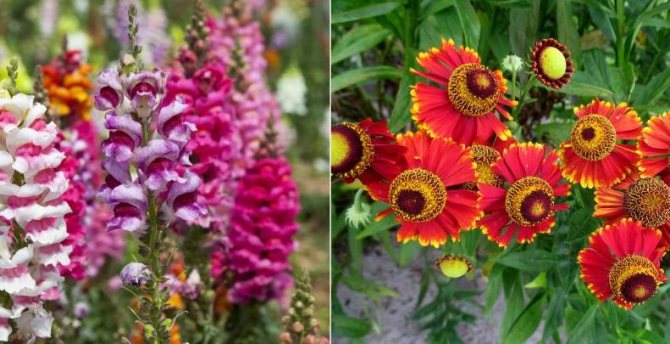

Calendula
People call it marigolds because of the unusual shape of the fruit. Catholic Christians decorated the statue of the Savior's mother with calendula and called it "Mary's Gold". The flower of "ten thousand years" - this is how it is called in China, where it symbolizes long life. In ancient India, garlands were woven from this plant and decorated with statues of saints.
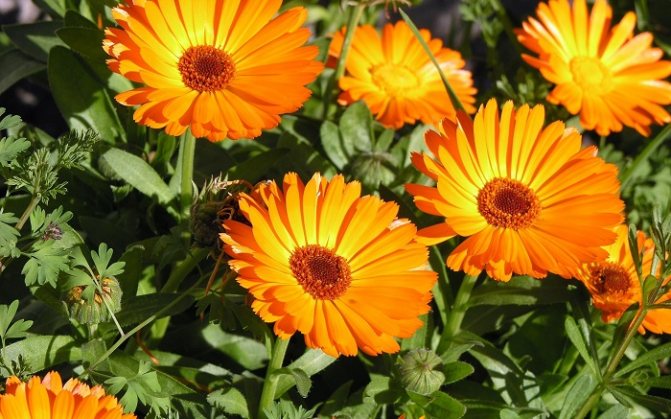

Another name for the flower is "the bride of summer" - because of its ability to turn after the sun. In the light, the petals bloom, and in the shade they gather. Because of this property, the ancient Romans called calendula "master's dial". They believed that in this way the plant makes it known about the coming of day and night. Another name is "calendar". Currently, the bred terry varieties with large inflorescences have lost the ability to close at night, but this name has remained.
Field paints


Field paints
Despite their modesty, wildflowers are no less beloved by gardeners. They give the flower beds a natural look.
Field crops on the territory give their advantages:
- the flowerbed looks more attractive and vital, because bees, butterflies begin to visit it
- thanks to naturalness, a cozy and unique atmosphere is created
- in most cases, these plants are medicinal, which can be very useful
back to menu ↑
Sage


Sage
Sage Medicinal plant. Even in combination with other colors, it does not lose its individuality and attractiveness. Grows well under any conditions and soil composition.
back to menu ↑
Liatris


Liatris
Liatris A flower of tenderness and romance. It also has properties that have many benefits. He looks very colorful. Caring for him is not difficult. Has a pleasant aroma. Creates a perfect combination in a group with other flowers and in border plantings.
back to menu ↑
Yarrow


Yarrow
Yarrow Possesses many wonderful qualities:
- perfectly decorates the flower garden
- looks beautiful in a bouquet on the table
- due to its medicinal properties, it should be in every first-aid kit
Gardeners also love this plant for that it is unpretentious in care, blooms for a long time and profusely.
back to menu ↑
Datura
Datura is an annual that is characterized by long flowering and incredible deep aroma of its flowers, resembling the shape of a bell. Due to its specific smell, the plant is popularly called dope. Datura is an unpretentious plant that grows no longer in height, but in width. With enough light and active care, a lush bush can bloom until late autumn.
The volume of the datura depends on the lighting, and the shadow location can completely lead to death. The plant should be watered abundantly, as its foliage evaporates a large amount of moisture. The soil should be drained and richly enriched with organic nutrients.
Gelenium
This plant is a real miracle of nature, opening up over the bush with a thick cap of incredible sunny, purple, orange flowers, the size of which does not exceed four centimeters. The flower is completely unpretentious. Its height can reach 1.5 meters. Gelenium prefers to grow in moist and fertilized soil. The plant will look great on the banks of water bodies, as well as a great addition to a flower bed. One of the most common varieties of gelenium is terry.
Marigold
The Latin name for this plant is Tagetes, as it was named after Taget, the grandson of Jupiter and the son of Genius. He became famous for his ability to predict the future. The boy had a high intellect and a unique gift of foresight. Before people, he appeared in the form of a baby, which a plowman found in a furrow.The kid taught to guess by the entrails of animals, and also told what would happen next in the world. Disappeared, as he had appeared, quite suddenly. His predictions were recorded in prophetic books and passed on to their descendants.
Rudbeckia hairy
Many people know these bright autumn yellow flowers with a brown core, making the plant very similar to a giant chamomile. The stem of rudbeckia can reach three meters in height, and the leaves are more than 20 centimeters. Such a miracle blooms until the frost. Rudbeckia prefers abundantly moistened soil, can be in the shade and do not wait for special care. The plant goes well with various coniferous shrubs.
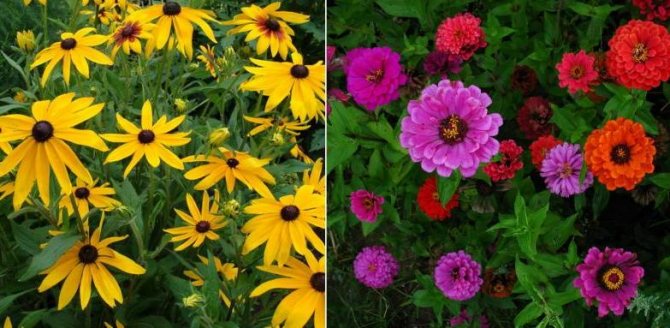

Chrysanthemums
Bush chrysanthemum is one of the most popular ornamental plants common in autumn gardens. Its flowers can have a variety of colors, including shades such as white, lilac, burgundy, as well as red, yellow and orange. Also, flowering may differ in the size of the bushes and inflorescences.
Early varieties of bush chrysanthemums bloom from late summer to October, and later varieties can wait for the onset of frost. Such flowers are unpretentious to weather conditions, but they still have some requirements. Chrysanthemum needs light soil, deeply loosened. Organic compounds in the fertilization process are encouraged.
Despite the fact that chrysanthemum loves moisture, in the cold season it needs drainage (drying the soil). This plant needs a top coat of mulch to protect and rescue the crop from cold temperatures.
Oaks, or Chinese chrysanthemums, are also popular. They bloom until the onset of severe frosts. The composition of the soil is not important for the oaks, but the presence of sunlight is necessary.
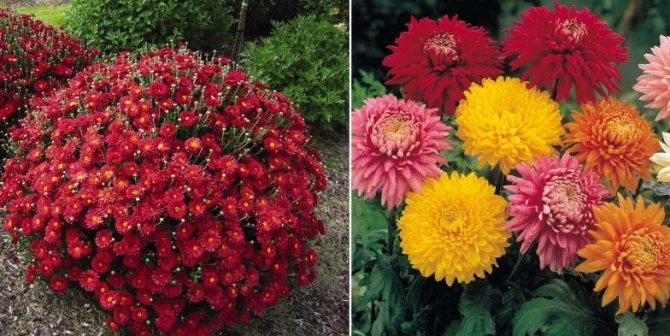

Dahlias
Dahlias are undoubtedly a great decoration for any garden. They can do without a lot of sunlight, and any kind of soil can suit them. It is worth noting that these flowers like moderate moisture, an excess of moisture can be destructive. In total, there are six main types: peony, anemic, needle-shaped dahlias, collar, as well as spherical and nymphaean.
Distinctive features are the shape, as well as the size of the plants, which can reach ten to twelve centimeters. Currently, about twenty thousand varieties of dahlias are known. These flowers are thermophilic, due to which their flowering continues only until the first low temperatures. Light frosts are detrimental to dahlias.
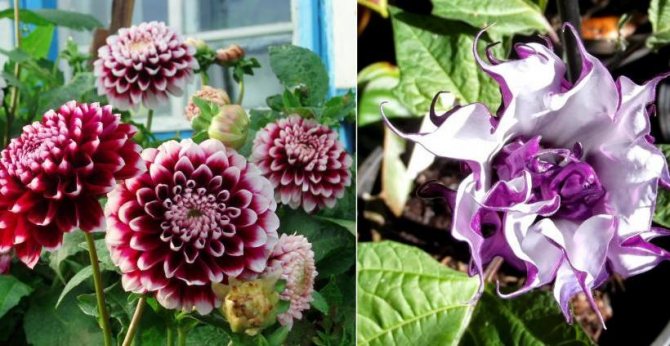

Phlox
Phlox are bright and voluminous autumn flowers. The plant belongs to perennials, its flowering begins around the middle of summer and lasts until the first frost. The height of herbaceous or bush phloxes can start from ten centimeters and exceed one and a half meters. The leaves of the flower are oval or egg-shaped, located at the top of the stem. Phloxes can be white, pink, purple, red, blue, and lilac. The plant has a pleasant fragrant aroma. The flower has five bent petals, which form corollas of various shapes - from star-shaped to saucer-like. The diameter of the flower usually reaches four centimeters, with a peephole in the center.
Photos of autumn flowers show the richness of shades.
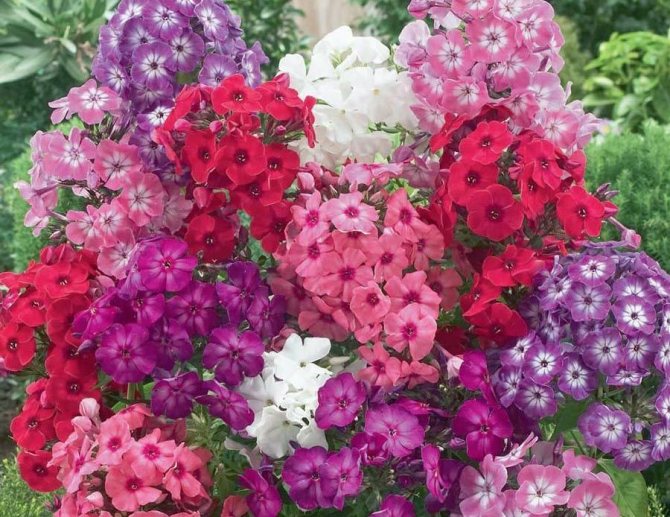

Petunia
A list of autumn colors would be incomplete without these messengers of summer. Petunias have more than twenty varieties, which are divided into both annuals and perennials. This plant copes well with almost any climatic conditions, without finding fault with the place of growth. Petunia can be called one of the main guests in any garden. The stems of the plant are often over ten centimeters in height. The flower will brighten up the garden perfectly in late autumn thanks to the variety of color palette. He not only perfectly tolerates the cold, but will also decorate a flower bed or borders in any weather.
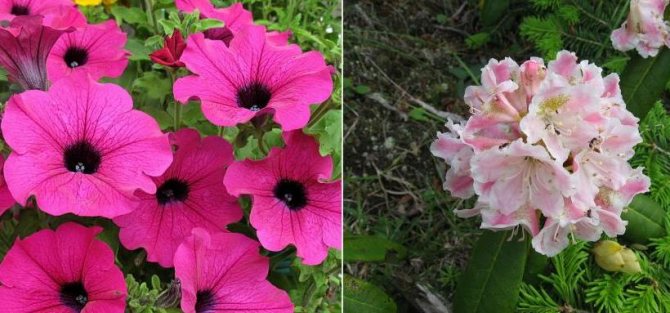

Pruning autumn flowers
The story about the plant of the autumn flower garden will not be complete if you do not remember the preparation of these plants for the winter and their pruning.
Perennial flower plants should be pruned for the winter. Because in the spring, old shoots will interfere with the young. Dried stems should not be cut to the ground, but leaving some of them with leaves to accumulate nutrients that will be needed next year. After pruning flowering plants, the ground near them must be loosened and fertilized in the form of humus or compost.
Shrub perennial flowers, such as roses, are also cut for the winter. First of all, damaged and immature shoots are removed. In roses, a lignified part of the stems is left. But the leaves and buds are also removed from them, as is the vegetation from under the bushes. This is done so that harmful insects are not bred there, which can contribute to the development of diseases or the spread of infection.
However, some fall plants, such as clematis, are pruned in early spring.
Time to dig up gladioli
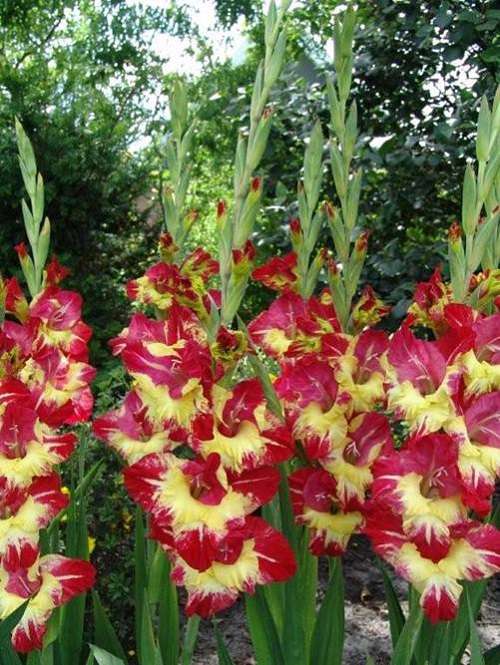

In the second half of September, we dig out gladioli. At the same time, it is important not to forget the main thing: the gladiolus bulb, after cutting the flower, fully ripens for about 40 days.
In this regard, so that we do not make a mistake with the timing of digging, it is best to just cut off all the flowers and unblown arrows one day, and after exactly 40 days, dig up the bulbs.
Also, you must take into account the climatic conditions of your area. Having dug out gladioli, we separate the baby, cut off the stem (leaving a stump of 1-2 cm) and roots, carefully remove the old corm.
Then we wash all the dug out bulbs in running water, pickle in a solution of potassium permanganate and lay them out to dry in a dry, well-ventilated place with a temperature preferably above 25 degrees, but not below 20-22 degrees.

